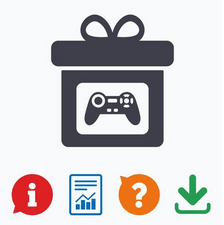 Gamification of learning emerged as a pedagogy in the early to mid-2000s with a “fad”ish following in higher education. But is the fad over? Maybe not! Another look may be warranted. Much has improved in learning technology since the early 2000s and the majority of Americans ages 18-29 say they often/sometimes play video games. Gamification of learning in 2020 has better tools and a new, receptive audience. I confess: Outside of the CITL space, my hobbies squarely set me in favor of video games. However, gamification of learning does not call for students playing video games to learn.
Gamification of learning emerged as a pedagogy in the early to mid-2000s with a “fad”ish following in higher education. But is the fad over? Maybe not! Another look may be warranted. Much has improved in learning technology since the early 2000s and the majority of Americans ages 18-29 say they often/sometimes play video games. Gamification of learning in 2020 has better tools and a new, receptive audience. I confess: Outside of the CITL space, my hobbies squarely set me in favor of video games. However, gamification of learning does not call for students playing video games to learn.
Noticeably, game-based learning and gamification of learning are quite different. The former involves students playing and/or designing their own games to learn, like playing Minecraft to learn Boolean logic. Gamification of learning occurs when elements of formal learning are restructured to resemble the logic of games. I’ll let an award-winning teacher render this principle in a more concrete way. Mika LaVaque-Manty won the 2014 American Political Science Association’s CQ Press Award for Teaching Innovation in Political Science with gamification of learning. Mika explains that this pedagogy means allowing:
- multiple paths to achievement (not everybody has to do the same assignments),
- safe failures (let’s allow students to practice the assignment instruments we impose on them before making them high stakes), and
- “leveling up” instead of “getting points taken off.” (Sage, 2014).
These changes make students an active agent of learning, improving learner engagement and motivation in the undergraduate classroom (Domínguez & Saenz-de-Navarrete et. al., 2013).
If you’re interested in some low stakes moves toward gamifying your classroom, here are two easy ways:
- Building a grade with experience: Each student starts a course at a zero that represents a fresh start, rather than a failing grade. I acknowledge this is not a perfect transfer of game logic because students bring with them funds of knowledge that enrich our classes. This “grade” of zero merely mimics the logic that players in new games typically begin with zero experience points. Each assignment or task in the class helps students build experience, and their experience points increase (possibly to thresholds that represent conventional letter grades).
- Viewing office hours as save points or check points: Gamification can be an answer to getting students to come to your office. Just as save points in video games are a check point in the game’s progression, a student needs to check in about their progress during office hours. The standard goals of office hours—students coming to a better understanding of their grade or of a tricky concept—is a check point.
For more tips and examples of gamification, come to a CITL event that features gamification!
Interested in talking about gamifying your own classroom? Consider attending the upcoming CITL workshop on Gamifying your Teaching and Classroom or contact our office for an individual consultation.
References:
Sage Publications (2014). How Do You (Successfully) Gamify a Course. An interview with Mika LaVaque-Manty. Retrieved October 26, 2015 from http://www.socialsciencespace.com/2014/08/how-do-you-successfully-gamify-a-course/
Domínguez, A., Saenz-de-Navarrete, J., de-Marcos, L., Fernández-Sanz, L., Pagés, C., and Martínez-Herráiz J. J. (2013). Gamifying learning experiences: Practical implications and outcomes. Computers & Education 63 (380–392).
Interested in talking about gamifying your own classroom? Consider attending the upcoming CITL workshop on Gamifying your Teaching and Classroom or contact our office for an individual consultation.

Leave a Reply